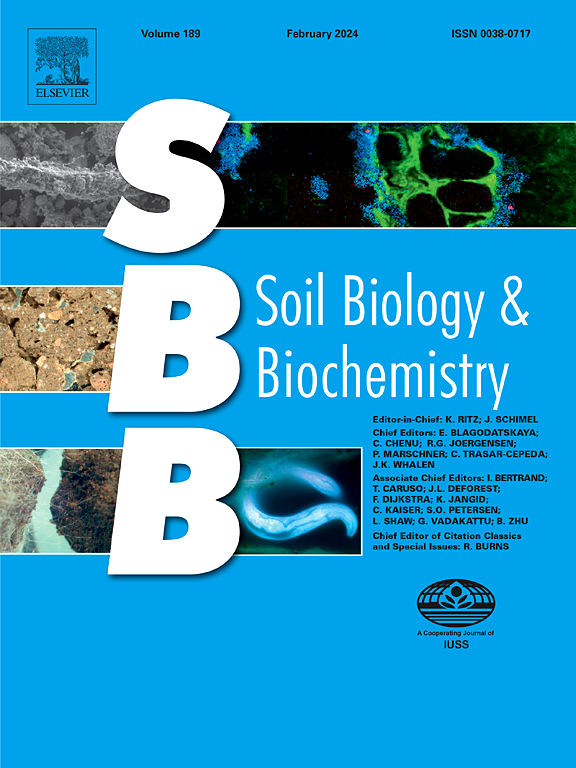Extrinsic rather than intrinsic factors determine microbial colonization of deadwood
IF 10.3
1区 农林科学
Q1 SOIL SCIENCE
引用次数: 0
Abstract
Deadwood decomposition is primarily attributed to wood-colonizing fungi and bacteria, driven mainly by intrinsic (e.g. tree species identity) rather than by extrinsic factors. A recent cross-ecosystem study, using gamma-sterilized wood blocks of different coniferous and deciduous tree species placed at 150 forest and 150 grassland sites, revealed that intrinsic factors most strongly influenced rate of decomposition. These results raised the question of whether the wood-colonizing microbial biodiversity follows similar assembly patterns. For this purpose, we used metabarcoding to analyse the fungal and bacterial communities colonizing the wood blocks. We discovered that the wood-colonizing communities were more strongly determined by extrinsic factors such as the ecosystem type and microclimate (air humidity, soil pH, soil moisture, soil temperature) than by intrinsic factors (tree species identity, wood pH, wood mass loss). Although overall these results seem to be more pronounced for fungi, both communities comprised highly specialized wood colonizers in both ecosystems. For instance, the fungal genus Mycena and the bacterial genus Granulicella were detected more frequently in forests, whereas Exophiala and Sphingomonas were more abundant in grasslands. Wood mass loss exhibited a stronger correlation with reduced fungal diversity, while bacterial richness displayed no association with mass loss, both within and across forest and grassland sites. However, the composition of both colonizers’ communities was consistently linked to wood mass loss. Our study suggests that the environment selects distinct wood-colonizing communities that differ greatly in their decomposition efficiency; this result highlights the importance of cross-ecosystem analyses to assess ecological patterns.
决定枯木微生物定殖的是外在因素而非内在因素
枯木分解主要归因于木材定殖真菌和细菌,主要由内在因素(如树种特性)而非外在因素驱动。最近的一项跨生态系统研究使用伽马射线灭菌的木块,将不同针叶树种和落叶树种的木块分别放置在 150 个森林和 150 个草原地点,结果显示,内在因素对分解率的影响最大。这些结果提出了一个问题:在木材上定居的微生物生物多样性是否遵循类似的组合模式。为此,我们使用代谢编码来分析木块上的真菌和细菌群落。我们发现,与内在因素(树种特征、木材 pH 值、木材质量损失)相比,生态系统类型和小气候(空气湿度、土壤 pH 值、土壤湿度、土壤温度)等外在因素对木材定殖群落的决定作用更大。虽然总体而言,这些结果似乎对真菌更为明显,但在这两个生态系统中,两个群落都由高度特化的木材定殖者组成。例如,真菌属 Mycena 和细菌属 Granulicella 在森林中的检出率更高,而 Exophiala 和 Sphingomonas 在草原中的检出率更高。木材质量损失与真菌多样性减少有更强的相关性,而细菌丰富度与质量损失没有关系,无论是在森林还是草地中都是如此。不过,两种定殖者群落的组成始终与木材质量损失有关。我们的研究系统表明,环境选择了不同的木材定殖群落,这些群落的分解效率差别很大;这一结果突出了跨生态系统分析对评估生态模式的重要性。
本文章由计算机程序翻译,如有差异,请以英文原文为准。
求助全文
约1分钟内获得全文
求助全文
来源期刊

Soil Biology & Biochemistry
农林科学-土壤科学
CiteScore
16.90
自引率
9.30%
发文量
312
审稿时长
49 days
期刊介绍:
Soil Biology & Biochemistry publishes original research articles of international significance focusing on biological processes in soil and their applications to soil and environmental quality. Major topics include the ecology and biochemical processes of soil organisms, their effects on the environment, and interactions with plants. The journal also welcomes state-of-the-art reviews and discussions on contemporary research in soil biology and biochemistry.
 求助内容:
求助内容: 应助结果提醒方式:
应助结果提醒方式:


